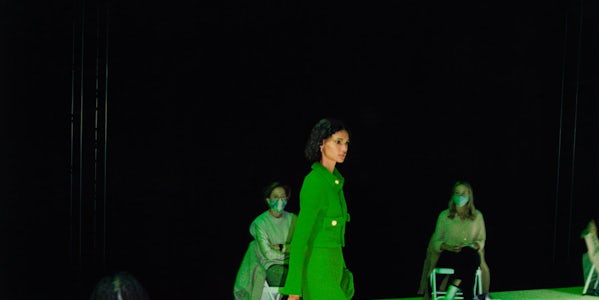With screen time on the rise, skin care comes for blue light
Last month, U.S. Surgeon General Dr. Vivek Murthy called for warning labels on social media platforms due to their potentially damaging effects on adolescents’ mental health. With screen time on the rise across demographics, public health officials like Dr. Murthy are raising the alarm about our devices’ negative impact on our physical and mental health. And some are asking if our screens may also impact our outer appearance.
“We spend more time in front of the screen than we do in front of the sun,” said Indianna Roehrich, founder of Tomorrow-Today Beauty. Roehrich launched the brand at the end of 2023, starting with the Tech Protect Serum, which promises to reverse the effects of screen time. “We’re in such a digitally driven world — it’s not going away. My screen time’s not reducing at all.”
The booming sun-care category is expected to reach $14.7 billion by 2028 and, consequently, it’s oversaturated. Brands are looking to stand out in new arenas for skin protection — and all day, every day most people are exposed to their screens and the potentially damaging blue light emitted from them. Tomorrow-Today Beauty’s $81 Tech Protect serum claims to protect skin from blue light with botanicals from Roehrich’s native country, Australia. Elsewhere in the industry, skin-care brand Ware launched in 2023 with its $65 Screencream at the forefront. The moisturizer claims to contain blue-light- and pollutant-blocking ingredients. Established brands have also launched blue-light products, like the Estée Lauder-owned Too Faced, which promotes blue-light defense in its antioxidant-infused Makeup Insurance setting spray and eyeshadow primer, and clean brand Ilia’s $38 Blue Light Mist, which claims to offer protection through tara extract. Outside of beauty, eyewear brands like Warby Parker have offered blue-light-protective glasses for years, while Saveface offers blue-light-blocking screen protectors for smartphones.
But, like with the introduction of any new or trendy product or benefit, blue-light-centric skin care also raises the question: Does our skin need protection from blue light or screens?
Blue light is defined as the spectrum of visible light that has a wavelength of 400-500 nanometers. Like UVA and UVB, blue light is emitted from the sun’s rays, though it has a different impact on our skin.
“There are two issues [with blue light]. One is hyperpigmentation, and two is accelerated aging, or the breakdown of collagen and elastin,” said Dr. Kseniya Kobets, director of cosmetic dermatology and assistant professor in dermatology at Montefiore-Einstein College of Medicine. Those already predisposed to hyperpigmentation are especially susceptible to blue light’s effects, like people with deeper skin tones or acne, she said, citing research published in 2020 in the Journal of the American Academy of Dermatology.
Our screens and the sun are the primary sources of blue light. But for some, the evidence that blue light emitted specifically from our screens has an impact on our skin is not convincing.
“The evidence [shows that] screens, cell phones and computers don’t emit enough blue light to be of concern for exposure. It’s just not enough, even if you are on screens for a long time,” said Christina Ross, director of science and policy at beauty retailer Credo.
Dr. Loretta Ciraldo, dermatologist and founder of her namesake skin-care brand Dr. Loretta, however, believes that the issues she sees among her patients in Florida are indicative of screens affecting our skin.
“The people who live here brush their teeth and put on sunscreen. So how is it that we’re still seeing a lot of melasma, a lot of uneven pigment and a lot of post-inflammatory hyperpigmentation after acne?” said Dr. Ciraldo. “In my opinion, from a practitioner’s point of view, [based on] talking to so many patients, it’s because everybody is being careful about the sun, but they’re not being that careful about their screens.”
While there is some crossover in products that promise blue-light protection and sun protection, broad-spectrum SPFs are not required to offer protection from visible light. Both Dr. Ciraldo and Dr. Kobets recommend products with iron oxide, which is often found in tinted sunscreens though it is not considered an SPF active ingredient, to protect from blue light. Zinc oxide, a physical SPF blocker, can also offer protection from blue light. But while sunscreen is strictly regulated by the FDA, there exists little regulation around messaging about blue-light protection.
“There really isn’t standardized criteria for blue-light protection,” said Dr. Ciraldo. “My opinion is very strong: We need blue-light protection. Secondly, we have to investigate when a brand says it has blue-light protection: How are they delivering that and how has it been verified?”
Blue-light protection labeling on products, whether they are proven to be effective or not, also speaks to changing expectations from our skin care. In recent years, trends have moved away from stripping acids and exfoliants in favor of reparative ingredients, with terms like “skin barrier” and “slugging” trending in product messaging and on social media.
“There had been an age where it was [about] every acid, every retinol: Let’s get red, let’s get flaky. If it doesn’t burn, it’s not working,” said Credo’s Ross. “Those days are past, and people want to protect, while also promoting cell turnover and helping the skin to have a youthful appearance.”
Roehrich believes there is a market for blue-light products on par with the booming sun-care market. This summer, she began selling Tomorrow-Today in the Soho-based health-food store Happier Grocer, but she has her sights set on the beauty giants, as well. “My goal is Sephora,” she said. The beauty retailer already carries Ilia’s and Too Faced’s blue-light-protecting products.
For Dr. Kobets, the appeal of a blue-light-centric product may come down to how dedicated users are to their routines. “There are different types of people out there. Some people want to do everything they can to try to fight hyperpigmentation and improve their skin health, especially if they’re already fighting an aging battle,” she said. “For the younger population, they’re waking up to preventative things they could do.”
Dr. Ciraldo would like to see more research on blue light from screens and its impact. But more consumer appetite may be needed to drive further scientific interest. “Industry has a huge influence, even on research. So much of the research dollars and the big studies in dermatology and at universities are funded by industry,” she said.
Time will tell if both commercial and scientific interests align on further blue-light and screen-time research. But the more wide-ranging impacts of screen time on our lives may never be cured by a skin care product, no matter how innovative.
“Two things that are very important to maintaining healthy skin and staying youthful are human connection — not having loneliness — and getting a good night’s sleep,” said Dr. Ciraldo. “Screen time is very detrimental to both.”



